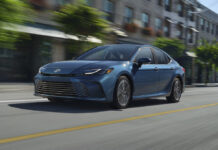
Toyota’s long anticipated mini-crossover, the C-HR, made its production debut at the 2016 Los Angeles Auto Show, and it looks like the company is trying to out-juke the Nissan Juke in the competitive subcompact crossover segment.
Looking much like the C-HR concept that debut in LA last year – it was called a Scion then – the 2018 Toyota C-HR is one of the most aggressively styled vehicles in the segment, especially next to the bland Honda HR-V and Chevy Trax and the cutesy Jeep Renegade. The only other car in the class to have such radical styling is the aforementioned Juke, with which the C-HR shares some styling cues.

The most distinctive part of the C-HR’s styling is the rear quarter panel and rear end treatment, which, like the Juke, has an exaggeratedly upswept C-pillar with integrated door handles and a steeply raked rear glass that, although stylish, will seriously reduce cargo capacity.
Despite the rear end and the wide tires and aggressive wheel arches, the front end is surprisingly not aggressive and refreshingly tasteful, especially after some of the ghastly front ends on some current Toyotas (Corolla, we’re looking at you).

From a styling perspective, the big news is inside. It is thankfully not as avant garde as the exterior, and in many ways is one of the best looking, best designed interiors to come out of Toyota in a long time. The 7-inch touchscreen is moved to the top, as it is in many other company’s cars (Audi, Mazda, Mercedes, etc.) and nicely integrated into the angled center stack.
Switchgear is simple and logically placed. A meaty steering wheel sits in front of a gauge cluster with two round dials and a 4.2-inch center screen. Without having a chance to sit in it, it seems like the C-HR’s interior is going to be a fine place to spend time behind the wheel.
More good news is found underneath the C-HR. It, like the Prius, is built on top of Toyota’s new TNGA platform (Toyota New Global Architecture), meaning it has increased stiffness and, lo and behold, a fully independent rear suspension.

The drivetrain, however, is a bit of a disappointment. Under the hood is a 2.0-liter four-cylinder engine making 144 horsepower and 140 lb-ft of torque, much less than the Juke’s 188 horsepower. It does beat the HR-V’s 141 – and with much more torque, so it will be competitive in the segment but not exceptional.
The power goes to the front wheels (Toyota’s specs had no all-wheel-drive option specified) through a continuously variable transmission. While this could be taken as more bad news, Toyota says they did a lot of work to the CVT to make it sportier, including revised pulleys and belts. It also has a sport mode that simulates seven gear ratios for those who want to pretend their car has a real, geared transmission.

While not vaulting to the top of the subcompact heap, the C-HR should be a strong competitor on its exterior and interior styling alone. The new chassis should make it decent to drive, but that won’t stop critics from wanting more power and a geared transmission.
The C-HR – an acronym for “Coupe High Rider” – will be available in Spring 2017 and will initially be available in XLE and XLE Premium trim levels. Pricing and fuel economy numbers have yet to be released.
TFLcar was at the Los Angeles Auto Show, and was there for the C-HR’s debut. Check out the full video above from the event.































